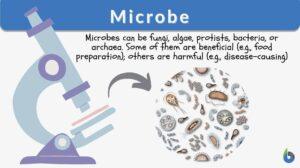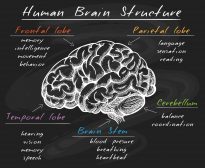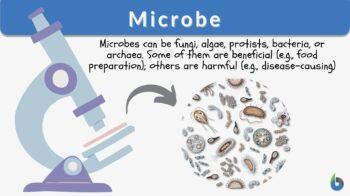
Microbe
n., plural: microbes
[ˈmaɪkɹoʊb]
Definition: Any of the microorganisms, especially those causing diseases or infections
Table of Contents
Microbe Definition
What is a microbe? How do we define microbes? Microbes refer to microorganisms that cannot be seen by naked eyes but can only be seen under a microscope. The term “microbes” is a general word that describes a numerous number of organisms. Examples of microbes are microscopic fungi, protozoa, algae, bacteria, and archaea. Is a virus a microbe? Not all consider viruses an organism. But for those who do, viruses could then be the smallest form of microbes.
Microbes have numerous shapes. Are all microbes considered harmful? Microscopic organisms can be either harmful microorganisms or beneficial microorganisms. Harmful types may cause mild or serious diseases in humans and animals. On the contrary, useful types may be beneficial for either the human body or in some industrial processes.
A microbe refers to any of the microorganisms, especially those causing diseases or infections. The term microbe was coined to refer collectively to microscopic organisms, including bacteria, fungi, protozoa, and viruses. However, the term is used commonly to denote any of the bacteria that are harmful, pathogenic. Etymology: Greek mīkro- (small)- + bíos (life). Synonym: microorganism (micro-organism).
Discovery
Microbes have been discovered many years ago. During every era, scientists classified them according to different features.
Ancient precursors
Ancient precursors varied according to different features. They noticed the presence of certain symptoms associated with certain diseases. They assumed that diseases were associated with the presence of certain agents transmitted from the diseased to the healthy person. However, they did not attribute illnesses yet to microbes. So ancient precursors correlated diseases to other factors such as the association of malaria with bad air. Therefore, hygiene was their approach to fighting malaria.
Other ancients used microbes without knowing they exist in some fields such as the fermentation process. Fruits and honey were used in the microbial fermentation process to make beverages. The steps of the discovery process of microbes in ancient precursors went as follows:
- Hippocrates, the father of western medicine, stated that diseases are caused within humans or by the environment surrounding them.
- Marcus Terentius proposed that diseases were caused by something that can not be seen. He warned others from living beside the swamps. Since he thought that minute creatures lived there spreading in the air and can enter the human body causing diseases.
- Girolamo Fracastoro suggested that diseases were transmitted from one person to another in ways such as by direct contact with the infected person or his clothes or being in contact with the infected air surrounding the infected person.
Early modern
- Athanasius Kircher studied the blood of patients infected with bubonic plague under a microscope. He found small “worms” that caused the plague. His discovery was considered the first theory of diseases caused by germs.
- Antonie Philips van Leeuwenhoek discovered a great number of living things or life forms under the microscope. But he did not correlate their existence with diseases. So, this observation was considered the first description of microorganisms.
- Sir John Pringle was the first scientist to propose using antiseptics in hospitals and quarters.
- Alexander Gordon was the first scientist to describe the contagious nature of puerperal fever. He also suggested that doctors who treated the patient must wash well to avoid being infected.
19th century
- John Goodsir was one of the first people to correlate disease with a specific microorganism. He examined the vomiting of a diseased person under the microscope and found microorganisms, which he called Sarcina ventriculi.
- Louis Pasteur worked on both the fermentation and pasteurization processes of milk and wine. He suggested that microorganisms present in the atmosphere were responsible for fermentation.
- Robert Koch detected microbes that caused anthrax, tuberculosis, and cholera.
Classification and Structure
Let us understand microbial evolution and the different types of microbes.
Evolution
In the evolutionary tree, the genes are transferred either vertically or horizontally, however, the evolution of microbes resembles a net where the transfer of genes occurs between several species at the same time.
Genes are transferred between microbes in several ways. Genes present in deoxyribonucleic acid (DNA) may be transferred from a donor to recipient bacteria through a tube connecting the two cells. Genes can also be transferred from one microbe to another through mobile plasmids.
Another method by which genes are transferred involves the bacteriophage, which is a virus that infects certain microbes and transfers its genes to another microbe by subsequently infecting it. All transferred genes may be inherited by the following generation contributing to their evolution.
For example, one of the most common evolutionary genes for microbes are antibiotic resistance genes where microbes develop mutations to protect them again antibiotics, these genes move to other cells by one of the three mechanisms- most commonly by plasmid- and recipient cells, as well as their next generations, become resistant to that certain type of antibiotic without even being exposed to it.
Archaea
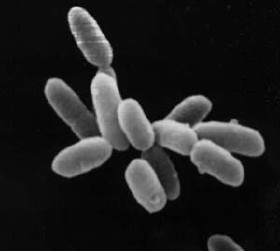
Archaea are primitive prokaryotic organisms; they lack a nucleus. There are two groups of archaea: (1) Crenarchaeota, ammonia-oxidizing microorganisms found in the soil, and (2) Euryarchaeota, found in the deep-sea marina. Archaea can be found in harsh environments, such as in high saline concentration, acidic, and anaerobic environments. Archaea can live in the human body. The structure of archaea is characterized by the presence of multiple RNA polymerase enzymes. The archaeal cell wall does not contain peptidoglycan. The glycerol and fatty acids are connected through ether bonds in archaea and not ester bonds as bacteria.
Bacteria
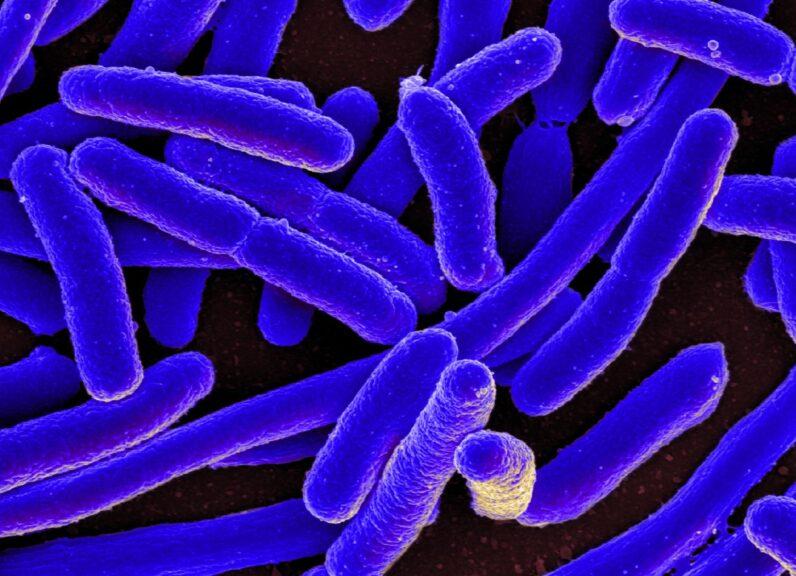
Are bacteria microbes? Bacteria are considered a type of microorganism. They are single-celled organisms that have a cell wall containing peptidoglycan. and contain a nucleoid as they do not have organized nuclei. Some microbial bacteria have a single loop of DNA at the center while others have a circular DNA called a plasmid. Here are some of the general features of bacteria:
- Bacteria are prokaryotic microorganisms.
- Bacteria are classified into groups depending on their shape. Bacteria under the microscope are as follows: cocci bacteria, corkscrew, rod (bacilli), vibrio, spiral.
- Bacteria may be found as singles or pairs or chains.
- Bacteria spread in every place on earth, from soil to the human body.
- Are bacteria a living thing? Bacteria are living things and can be either pathogenic microorganisms and cause diseases or can be useful like human microbes in the gastrointestinal or respiratory tracts.
- Bacteria are covered with two layers — outer cell wall and inner cell membrane. Conversely, Mycoplasma bacteria do not have a cell wall. Others have a third layer called a capsule.
- Some bacteria move via flagella or pili.
- Bacteria are either gram-negative or gram-positive according to their peptidoglycan layer thickness and the existence of an outer lipid membrane.
Eukaryotes
Microbial eukaryotes have three groups as follows:
Protists
Protists are unicellular eukaryotic microorganisms. They have a nucleus and other membrane-bound organelles. Some protists have the ability to do photosynthesis to make nutrients using sunlight (called photoautotrophs). Others swallow up food, as heterotrophs.
Fungi
Fungi microorganisms are eukaryotes. While many are multicellular, there are fungi that are single-celled, particularly yeast (Saccharomyces). Mushrooms and molds are fruiting bodies of fungi that under the microscope appear as long fibrous structures (hyphae).
Plant-like Microbes
Algae are plant-like microorganisms because they have chloroplasts. But aside from chloroplasts, they have other plastids that give them colors other than green. There are macroalgae, such as kelps, but those that are considered microorganisms are single-celled algae, such as diatoms and dinoflagellates. Algae thriving in aquatic habitats, such as marine and freshwater, are members of the plankton.
Ecology
Microorganisms can be found in every part of the earth depending on their adaptation to the surrounding environment.
Extremophiles
Extremophiles are mainly prokaryotes (bacteria or archaea). Extremophiles are organisms that can bear environmental extreme conditions. They exist in different extreme conditions as follows:
- Acidophilic conditions: where acidophilic organisms grow in pH between 1 to 5
- Alkaliphilic conditions: where alkaliphilic organisms live in pH over 9
- Halophilic conditions: halophilic organisms grow in high concentrations of salt
- Thermophilic conditions: thermophilic organisms grow in high temperatures
- Psychrophilic conditions: psychrophilic organisms grow in extremely low temperatures
- Barophilic conditions: the growth of barophilic organisms requires high pressure
- Oligotrophic conditions: they grow in an environment that has a shortage of nutrients
- Xerophilic conditions: where the growth needs dry conditions and a minimal amount of water
Plants and soil
There are numerous microbes in soil and plants. For example, the symbiotic nitrogen-fixing bacteria and mycorrhizal fungi, have a beneficial role where they improve the nutrition of the plant through minerals. Different types of microbes developed adaptation methods to survive inside the soil, plant roots, or exudates. However, not all microbes are beneficial for plants and soil, where some microbes can infect plants and diminish them.
Symbiosis
Symbiosis is a long-term relationship between two or more organisms or organisms and other biological species. symbiosis differs according to benefits as follows:
- Mutualism: where both species benefit from this interaction. For example, Escherichia coli microbes exist inside the human gut where they get nutrients, while humans benefit from their existence as they produce important vitamins for humans such as vitamin K.
- Commensalism: where one of the species benefits while the other remains unaffected, such as the commensal microorganisms Staphylococcus epidermidis found on our skin using dead skin cells for nutrition. A healthy human does not benefit or harm from their presence.
- Parasitism: when one of the species harms the other. The relationship between humans and pathogenic disease-causing microorganisms or parasites is an example of parasitism.
Applications
Microbes are utilized in numerous applications such as:
1. Food production
Microbes can be used to produce foods such as bread, fermented meat, and fish, fermented milk products such as cheese and yogurt, or even in the preservation of different foods.
2. Water treatment
Microbes are used in cleaning water to be consumed by humans. The general role of microbes is to convert toxic substances found in water to harmless substances. For example, the conversion of organic matter to CO2 and H2O by using microorganisms and their enzymes. This technology is known as bioremediation. There are many microbes to be used in water treatment as follows:
- Aerobic microorganisms: uses free oxygen in the water to degrade toxins in the wastewater.
- Anaerobic microorganisms: they are used to convert toxins water into methane gas.
- Obligate anaerobic bacteria are commercially cheap since they do not need oxygen to purify water.
- Facultative: they are types of bacteria that can be either aerobic or anaerobic depending on the environment.
3. Energy
Microorganisms can be used to produce energy. Using microorganisms in generating energy is a cheap and reproducible method. Hydrogen is produced using cyanobacteria in a process called oxygenic photosynthesis using water and sunlight only. Moreover, methane is another fuel that can be generated by microbes in a process known as methanogenesis. Also, electrical energy is generated using microbes using a microbial fuel cell which depends on the decomposition of organic or inorganic matter at the anode using specific organisms, which leads to flowing electrons from the anode to the cathode through a conductive matter such as copper generating electricity.
4. Chemicals, enzymes
The usage of microbes in the chemical industry is referred to as industrial microbiology. As microbes can produce citric acid and other organic acids fermentation of lemon. Organic acids also may be produced using glucose by Aspergillus niger bacteria. Microbial enzymes can be used in commercial fields since they are more stable than animal enzymes. Microbial enzymes can be used in the production of glucose syrups, the paper industry, and decreasing the viscosity of starch. One of the most widely used enzymes is alpha-amylases that are able to break down alpha 1,4 glycosidic bonds of polysaccharides such as starch, producing a short chain of dextrins.
5. Science
Microbes are extremely important in different fields of research. They contribute to many molecular biology breakthroughs such as understanding the mechanism of protein synthesis and genetic coding. Microbes are used as an example of how biological systems work, therefore, using microbes helps in the development of new medicines, production of new enzymes used in medical or industrial fields, clinical diagnosis, forensics, and DNA applications such as cloning.
Many pharmaceutical products were developed and discovered using microbial biotechnology to cure several diseases. For example, human insulin hormone was produced using genetically modified microbes to control diabetes. Moreover, a huge number of vaccines are manufactured using attenuated or modified microbes to prevent serious infections.
6. Warfare
Bacterial agents, toxins, and viruses expose the health of humans to danger. These agents can be used in warfare attacks. Bioterrorist attacks pose challenges to human health as they are difficult to contain. For example, the plague in the ancient era killed a great number of people and the bodies of dead victims were moved to other cities to spread the disease. Indian populations were infected with smallpox after supplying them with linens and blankets used by smallpox patients. Biological weapons are dangerous since they can spread easily in the form of aerosols or by introducing microbes in food or clothes.
7. Soil
Indigenous microorganisms have a role in biodegradation, improving soil fertility, and nitrogen fixation in the soil. There are five types of microbes that live in the soil; bacteria, which are responsible for the final stage of breaking down nutrients in the root of the plant.
Actinomycetes are a type of fungi that act as an antibiotic. Moreover, fungi such as mycorrhiza live in roots, they facilitate water reuptake by roots.
Protozoa eat harmful bacteria that harm the plant and consume nutrients.
Nematode worms are found around the plant to protect the plant from different pathogens.
Human Health
Microbes affect human health in different ways such as discussed below.
Human gut flora
What are microorganisms in the human gut? Human gut flora contains about 300 to 500 types of microorganisms. It is important for the health of humans in many ways since flora can protect humans from diseases by competing with other bacteria, additionally, the normal flora can also protect the gut against inflammation. It also helps in the fermentation of non-digestible substrates such as fibers to produce short chains of fatty acids such as acetate, butyrate, and propionate.
Disease
Microbes can infect humans. Some infections can be easily managed by the immune system while others can be severe and life-threatening. Microbes may infect the respiratory tract causing tuberculosis, the gastrointestinal tract causing diarrhea, and the urogenital tract causing cystitis.
Hygiene
Hygiene is the main weapon for humans to protect themselves against microbes. The human body can be protected from microbes by washing and disinfecting hands frequently, brushing teeth twice daily, washing the whole body every day, and shortening nails to avoid infections.
Try to answer the quiz below to check what you have learned so far about microbes.
References
- 1.1 What our ancestors knew – Microbiology. OpenStax. (n.d.). Retrieved March 7, 2022, from https://openstax.org/books/microbiology/pages/1-1-what-our-ancestors-knew?query=okazaki
- Admin. (2020, October 12). The role of microorganisms in Industrial Products. BYJUS. Retrieved March 7, 2022, from https://byjus.com/biology/microbes-in-industrial-products/
- Applications of microbiology. http://www.madhavuniversity.edu.in/. (n.d.). Retrieved March 7, 2022, from https://madhavuniversity.edu.in/applications-of-microbiology.html
- BBC. (n.d.). Plants – variety of living organisms – GCSE biology (single science) revision – BBC bitesize. BBC News. Retrieved March 7, 2022, from https://www.bbc.co.uk/bitesize/guides/zr46fg8/revision/3
- Beneficial uses of microbes. FutureLearn. (n.d.). Retrieved March 18, 2022, from https://www.futurelearn.com/info/courses/introduction-to-microbiology/0/steps/51437
- Boundless. (n.d.). Boundless microbiology. Lumen. Retrieved March 7, 2022, from https://courses.lumenlearning.com/boundless-microbiology/chapter/microbial-symbioses/
- Daisy. (2018, March 2). The history of germ theory in the college collections. Royal College of Physicians of Edinburgh. Retrieved March 7, 2022, from https://www.rcpe.ac.uk/heritage/history-germ-theory-college-collections
- Encyclopædia Britannica, inc. (n.d.). Archaea. Encyclopædia Britannica. Retrieved March 7, 2022, from https://www.britannica.com/science/archaea
- Encyclopædia Britannica, inc. (n.d.). Extremophile. Encyclopædia Britannica. Retrieved March 7, 2022, from https://www.britannica.com/science/extremophile
- Encyclopedia.com. (2022, March 18). .” infectious diseases: In context. . Encyclopedia.com. 28 Feb. 2022 . Encyclopedia.com. Retrieved March 18, 2022, from https://www.encyclopedia.com/media/educational-magazines/microbial-evolution
- Ersek, K. (n.d.). 5 types of soil microbes and what they do for plants. 5 Types of Soil Microbes And What They Do For Plants. Retrieved March 7, 2022, from https://www.holganix.com/blog/5-types-of-soil-microbes-and-what-they-do-for-plants
- Jacoby, R., Peukert, M., Succurro, A., Koprivova, A., & Kopriva, S. (2017, September 19). The role of soil microorganisms in plant mineral nutrition-current knowledge and future directions. Frontiers in plant science. Retrieved March 18, 2022, from https://www.ncbi.nlm.nih.gov/pmc/articles/PMC5610682/
- Libretexts. (2022, March 5). 4.1: Prokaryote habitats, relationships, and microbiomes. Biology LibreTexts. Retrieved March 18, 2022, from https://bio.libretexts.org/Bookshelves/Microbiology/Microbiology_(OpenStax)/04%3A_Prokaryotic_Diversity/4.01%3A_Prokaryote_Habitats_Relationships_and_Microbiomes
- McRae, B., Beth McRae posts by B. (2021, February 11). Diving into a world of microscopic plants • scuba diver life. Scuba Diver, Life. Retrieved March 18, 2022, from https://scubadiverlife.com/diving-world-microscopic-plants/
- Microbes A-Z: Your questions answered. AMNH. (n.d.). Retrieved March 7, 2022, from https://www.amnh.org/explore/microbe-facts
- Muscle Fibre types. Physiopedia. (n.d.). Retrieved February 27, 2022, from https://www.physio-pedia.com/Muscle_Fibre_Types
- Rani, N., Sangwan, P., Joshi, M., Sagar, A., & Bala, K. (2019, July 11). Microbes: A key player in industrial wastewater treatment. Microbial Wastewater Treatment. Retrieved March 7, 2022, from https://www.sciencedirect.com/science/article/pii/B9780128168097000051
- Raveendran, S., Parameswaran, B., Ummalyma, S. B., Abraham, A., Mathew, A. K., Madhavan, A., Rebello, S., & Pandey, A. (2018, March). Applications of microbial enzymes in the food industry. Food technology and biotechnology. Retrieved March 7, 2022, from https://www.ncbi.nlm.nih.gov/pmc/articles/PMC5956270/
- Renna Eliana Warjoto Lecturer at the Faculty of Biotechnology. (2021, September 15). This is how microorganisms can produce renewable energy for US. The Conversation. Retrieved March 7, 2022, from https://theconversation.com/this-is-how-microorganisms-can-produce-renewable-energy-for-us-149933
- Role of microorganisms & microbes used in wastewater treatment. AOS Treatment Solutions. (2018, July 23). Retrieved March 7, 2022, from https://aosts.com/role-microbes-microorganisms-used-wastewater-sewage-treatment/
- Society, M. (n.d.). Microbes and disease: Microbes and the human body. Microbes and the human body | Microbiology Society. Retrieved March 7, 2022, from https://microbiologysociety.org/why-microbiology-matters/what-is-microbiology/microbes-and-the-human-body/microbes-and-disease.html
- SparkNotes. (n.d.). Sparknotes. Retrieved March 7, 2022, from https://www.sparknotes.com/biology/plants/plantstructures/section2/
- Thavaselvam, D., & Vijayaraghavan, R. (2010, July). Biological Warfare Agents. Journal of pharmacy & bioallied sciences. Retrieved March 18, 2022, from https://www.ncbi.nlm.nih.gov/pmc/articles/PMC3148622/
- U.S. National Library of Medicine. (1970, January 1). Microbial Energy Conversion. National Center for Biotechnology Information. Retrieved March 7, 2022, from https://www.ncbi.nlm.nih.gov/books/NBK563531/
- Valdes, A. M., Walter, J., Segal, E., & Spector, T. D. (2018, June 13). Role of the gut microbiota in nutrition and health. The BMJ. Retrieved March 7, 2022, from https://www.bmj.com/content/361/bmj.k2179
- Vidyasagar, A. (2021, October 14). What are bacteria? LiveScience. Retrieved March 7, 2022, from https://www.livescience.com/51641-bacteria.html
- Vidyasagar, A. (2022, February 14). What are protists? LiveScience. Retrieved March 7, 2022, from https://www.livescience.com/54242-protists.html
©BiologyOnline.com. Content provided and moderated by Biology Online Editors.

